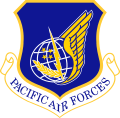This article has multiple issues. Please help improve it or discuss these issues on the talk page . (Learn how and when to remove these messages)
|
| Clark Air Base | |
|---|---|
| Part of the United States Air Force and Philippine Air Force | |
| Located at the Clark Freeport Zone, Philippines | |
 Clark Air Base in 1989 as part of United States Pacific Air Forces | |
| Site information | |
| Type | Air base |
| Owner | |
| Controlled by | |
| Condition | Renovated |
| Location | |
 | |
| Coordinates | 15°11′09″N120°33′35″E / 15.18583°N 120.55972°E |
| Site history | |
| Built | September 1, 1903 |
| Built by | |
| In use | 1903–1942 1942–1945 1945–1991 1991–present |
| Garrison information | |
| Garrison |
|
Airfield information | |||||||||||||||
|---|---|---|---|---|---|---|---|---|---|---|---|---|---|---|---|
| Summary | |||||||||||||||
| Elevation AMSL | 148 m / 484 ft | ||||||||||||||
| Coordinates | 15°11′09″N120°33′35″E / 15.18583°N 120.55972°E | ||||||||||||||
| Map | |||||||||||||||
| Runways | |||||||||||||||
| |||||||||||||||
Clark Air Base is a Philippine Air Force base in Luzon, located 3 miles (4.8 km) west of Angeles City, and about 40 miles (64 km) northwest of Metro Manila. It was previously operated by the U.S. Air Force and, before that, the U.S. Army, from 1903 to 1991. The base covered 14.3 square miles (37 km2) with a military reservation extending north that covered another 230 square miles (600 km2).
Contents
- History
- Establishment and prewar era
- World War II era
- Postwar era
- During the Marcos dictatorship
- Later years and transfer to the Philippines
- Visiting Forces Agreements
- Military units
- Culture
- Recreation
- Pop culture references
- Education
- Higher commands
- Climate
- See also
- References
- Bibliography
- Further reading
- External links
The base was a stronghold of combined Philippine and American forces during the final months of World War II, and a backbone of logistical support during the Vietnam War until 1975. Following the departure of American forces in 1991 due to the eruption of Mount Pinatubo and rejection by the Philippine Senate for renewing the presence of U.S. military bases in the Philippines, [1] [2] [3] the base became the site of Clark International Airport, as well as the Clark Freeport Zone and the Air Force City of the Philippine Air Force.
In 2014, the United States and the Philippines signed the Enhanced Defense Cooperation Agreement, which allows the United States to rotate troops into the Philippines for extended stays and allows the United States to build and operate facilities on Philippine bases for both American and Philippine forces. [4] While it did not allow the U.S.to establish any permanent military bases, it allows for the return of a rotational US troop presence in the former US bases, including Clark. [4]




